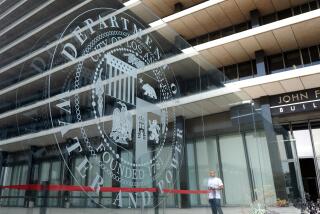Panel gives DWP 2 weeks to account for nonprofits’ spending
Newly appointed commissioners of the Los Angeles Department of Water and Power have given officials two weeks to account for millions of ratepayer dollars spent by a pair of nonprofit trusts created to improve relations between the city-owned utility and its largest employee union.
DWP managers said last month that they had scant records showing how more than $40 million had been spent since 2000 by the Joint Training Institute and the Joint Safety Institute, which are co-managed by the department and the International Brotherhood of Electrical Workers Local 18.
On Tuesday, new DWP commissioners appointed by Mayor Eric Garcetti — who was elected this year after vowing to rein in salaries and benefits at the utility — demanded a detailed accounting of about $3 million spent by the nonprofits in fiscal 2012.
Leaders of the DWP and the union have been under siege from the mayor’s office, the city controller and members of the City Council since The Times reported two weeks ago that nobody could explain how the ratepayer money had been spent.
DWP General Manager Ron Nichols said Tuesday: “There is no reason for not having greater transparency with respect to this.”
But producing the records from the jointly run organizations could require cooperation from the union, which appoints half of the nonprofits’ board members, and has so far been unwilling to provide any detailed public accounting of the groups’ spending. The union’s business manager, Brian D’Arcy, could not be reached for comment Tuesday.
The union refused a Times request for the nonprofits’ financial records in August, arguing that the labor organization is not a government agency and therefore not bound by public disclosure requirements.
The five-person DWP commission met for the first time Tuesday with four new members appointed by Garcetti.
One of the new commissioners, former U.S. Rep. Mel Levine, asked the department to produce records explaining a range of expenditures listed on the nonprofits’ publicly available tax returns, which offer only summaries of broad categories of spending.
Levine asked for more specific information about $631,440 spent by the training institute on “administrative expenses” in fiscal 2012 and $663,481 spent on “other.” He also asked for records of travel expenditures. The tax returns show the two institutes spent more than $360,000 on travel from fiscal 2010 to fiscal 2012, but they don’t indicate who traveled or where they went.
The organizations, which were created after a round of job cuts at the department in the late 1990s, receive up to $4 million per year in ratepayer funds.
Jack Humphreville, a member of the Greater Wilshire Neighborhood Council and frequent critic of the DWP, said he believes the organizations were created to “absorb a bunch of overhead for the IBEW because their dues went down.”
Limited records that the department provided under the California Public Records Act showed the organizations have been spending about $1 million per year on the salaries of a few administrators, including $171,361 in 2012 paid to Jon Pokorski, who is listed as the union president on the IBEW Local 18 website.
The broad purpose of the organizations, city records show, has been to “identify” safety and training as core values at the department, and to promote “communication, mutual trust and respect” between DWP managers and the electrical workers’ union.
Ordinances establishing the nonprofits in 2000 and 2002 don’t specify how the ratepayer money should be spent. The department has separate safety and training programs.
Last week D’Arcy sent a letter to Councilman Felipe Fuentes saying that the organizations have helped address disparate and inefficient training and safety programs at the DWP.
He said the institutes had created and implemented a department-wide “safety information and action program” that trained 7,800 employees and a “field ergonomics initiative that has helped more than 3,500 journeymen and women learn to work both smart and safely.”
More to Read
Sign up for Essential California
The most important California stories and recommendations in your inbox every morning.
You may occasionally receive promotional content from the Los Angeles Times.










